Department of Zoology, Shivramji Moghe College, Pandharkawada, India.
Corresponding author email: ramzan_virani@yahoo.co.in
Article Publishing History
Received: 18/06/2021
Accepted After Revision: 25/09/2021
Pandharkawada forest division is located in biodiversity rich landscape of Maharashtra, India. 296 birds distributed in different habitats are recorded from this forest division belongs to 19 orders 69 families. From the recorded 296 species, 10 species are near threatened, 2 vulnerable and 1 is endangered (IUCN red data book). 74% species are occurred as common, 17% as uncommon, 5% rare and 14% as very rare. 56% are distributed as resident, 21.28%, are winter visitors 7.50% vagrant, 6.41% are distributed from winter to summer, 6.41% are recorded from monsoon to winter, 4 are monsoon to summer, 2 are monsoon visitor and 1 is summer visitor.
Main food habit of recorded species are insectivores and carnivorous followed by frugivores, granivores, terrestrial grazer, nectarivores, folivores, aquatic grazer, and scavengers. Study of their habitat reveals 56% are arboreal, 22% as shore birds 10% water birds 8% ground birds and 3% as arial birds. Their nesting type is recorded as, 48% as tree nesters, 17% in ground scrap, 12% built nests floating on water 8% in ground, 8% in tree hole and 7% in rock cleft. In a way they directly impacts human health, economy, food production as well as millions of other species. Therefore, it is to know about local bird diversity and its ecology. This study establishes Pandharkawada forest division is rich in avifaunal diversity due to varied habitats like forest, grassy patches, shrubs, perineal waterbodies and seasonal wetlands. Due to this, it attracts varieties of local resident and migratory species and different species, found distributed in different seasons of the year.
Bio-Indicators, Conservation, Consumer, Ecology, Pollinator
Virani R. S. Avian Diversity Assessment of a Tropical Forest in Central India. Biosc.Biotech.Res.Comm. 2021;14(3).
Virani R. S. Avian Diversity Assessment of a Tropical Forest in Central India. Biosc.Biotech.Res.Comm. 2021;14(3). Available from: <a href=”https://bit.ly/3zXAbqj“>https://bit.ly/3zXAbqj</a>
Copyright © Virani et al., This is an open access article distributed under the terms of the Creative Commons Attribution License (CC-BY) https://creativecommns.org/licenses/by/4.0/, which permits unrestricted use distribution and reproduction in any medium, provide the original author and source are credited.
INTRODUCTION
Avian population has a central role in ecosystem functioning and ecosystem services. Birds are bio-indicators and appraise the health of environment and ecosystems, they are capable of determining environmental integrity using their functions and populations. Birds play pivotal ecological roles both in forest and farmland ecosystems, notably pollination, seed dispersal, and pest control (Whelan et al. 2008; Mulwa et al. 2012). In addition to above, there is positive role of birds in nutrient cycling and soil formation.
They also richly contribute to the recolonization and restoration of disturbed ecosystem as per (Sekercioglu et al. 2004; Sekercioglu 2006). A study inferred that, birds are also act as mobile links that transfer energy both within and among ecosystems that are crucial for maintaining ecosystem function and resilience (Lundberg and Moberg 2003). In a way it directly impacts human health, economy, food production as well as millions of other species. Therefore, it is to know about local bird diversity and its ecology (Ndang’ang’a et al. 2013).
In Vidarbha region of Maharashtra 413 species are recorded by various authors. The annotated checklist of Nagpur area represented 284 species of birds. 171species are studied from Pohara-Malkhed reserve Forest, district Amravati (Wadatkar and Kasambe 2002; Kasambe 2009). 135 species of birds are observed in and around Ambazari Lake Nagpur (Kedar 2012). Total 312 species of birds recorded from the nearby area of Navegaon National Park Gondia 76 species of birds are reported from Chaprala wild life sanctuary, Gadchiroli (Paliwal 2013; Chauhan and Dhamani 2014; Wagh and Tiwari 2020).
92 species of birds are studied from Tamkarada forest near Malegaon tehsil of Washim district (Ingle et al. 2015). 99 species of birds are listed from Junona lake Chandrapur Increasing anthropogenic pressure, change in land use patterns, commercial exploitation of waterbodies and seasonal wetlands, forest fire, rampant grazing, overuse of pesticides and herbicides rapidly eats up natural habitats of birds. Most deforestation has happened in biodiversity-rich tropical forests (Asner et al. 2009: Hansen et al. 2013; Harney 2015). These areas are expected to face even more pressures in the future, largely due to agricultural expansion and increased industrialization (Tilman and Fargione 2001: Dobrovolski et al. 2011: Wagh and Tiwari 2020).
In this context, the conservation of this ecologically important fauna is paramount and this research exercise of systematic study on bird diversity assessment in different habitat is undertaken from June 2015 to December 2020 to understand and document local diversity, distribution, habit, habitat, nesting type and conservation status of birds of Pandharkawada forest division. This will help in devising practice of conservation.
MATERIAL AND METHODS
Pandharkawada forest division, located at south-eastern part of Maharashtra and situated in the geographic coordinates of 78°14′ & 79°13′ East and 19°45′ & 20°20′ North, spread over 655.336 square kilometer. It constitutes a compact patches of dense forest cover, open forest, shrubs and grassy belts and associated having great value from the point of view of wildlife and bio-diversity conservation.
The main portion of forests constitutes the dry Teak bearing forests bearing 60 percent of the total crop composition, so classified as Dry Teak Bearing forests. The bird survey was conducted from June 2015 to December 2020 using standard point count method. Binocular (Nikon 10×40 8.2 0) and camera (Nikon D700, 150-500 Sigma lens) was used for bird watching and to photograph them.
They were identified and classified on the basis of the “The Book of Indian Birds” by Ali (eds.1996) and “Pocket Guide of Birds of the Indian Subcontinent” by Grimmet and Inskipp (eds.2000). Diversity of bird was taxonomically classified and categorized on threaten scale by using latest IUCN Red list (Ali 1996; Grimmet and Inskipp 2000).
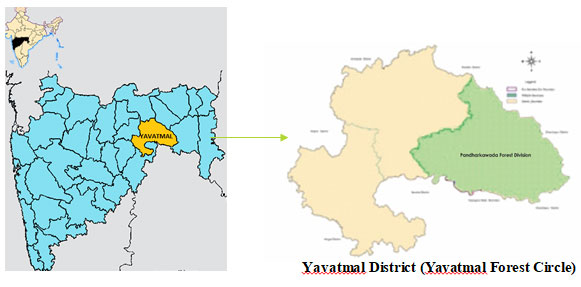
Source: https://www.veethi.com/places/maharashtra-yavatmal-district-405.htm
The data collected from the surveys were used to assess habit, habitat, nesting type, occurrence and distribution. Surveys were conducted four days in a week, from sunrise to 4 hours after sunrise and from 4 hours before sunset until sunset. Morning and evening counts were altered between sites. Each of the sites was surveyed daily depending on weather conditions. Birds seen were identified and recorded along the habitat type and status and checklists were prepared.
RESULTS AND DISCUSSION
296 species of birds were studied from Pandharkawada forest division from June 2015 to December 2020. Habit, habitat, nesting type, occurrence, distribution and IUCN status of these recorded species were studied.
Table 1. (Part-A) Bird Diversity of Pandharkawada Forest DivisionTable 1 (Part-B) Bird Diversity of Pandharkawada Forest Division

Table 1 (Part-B) Bird Diversity of Pandharkawada Forest Division
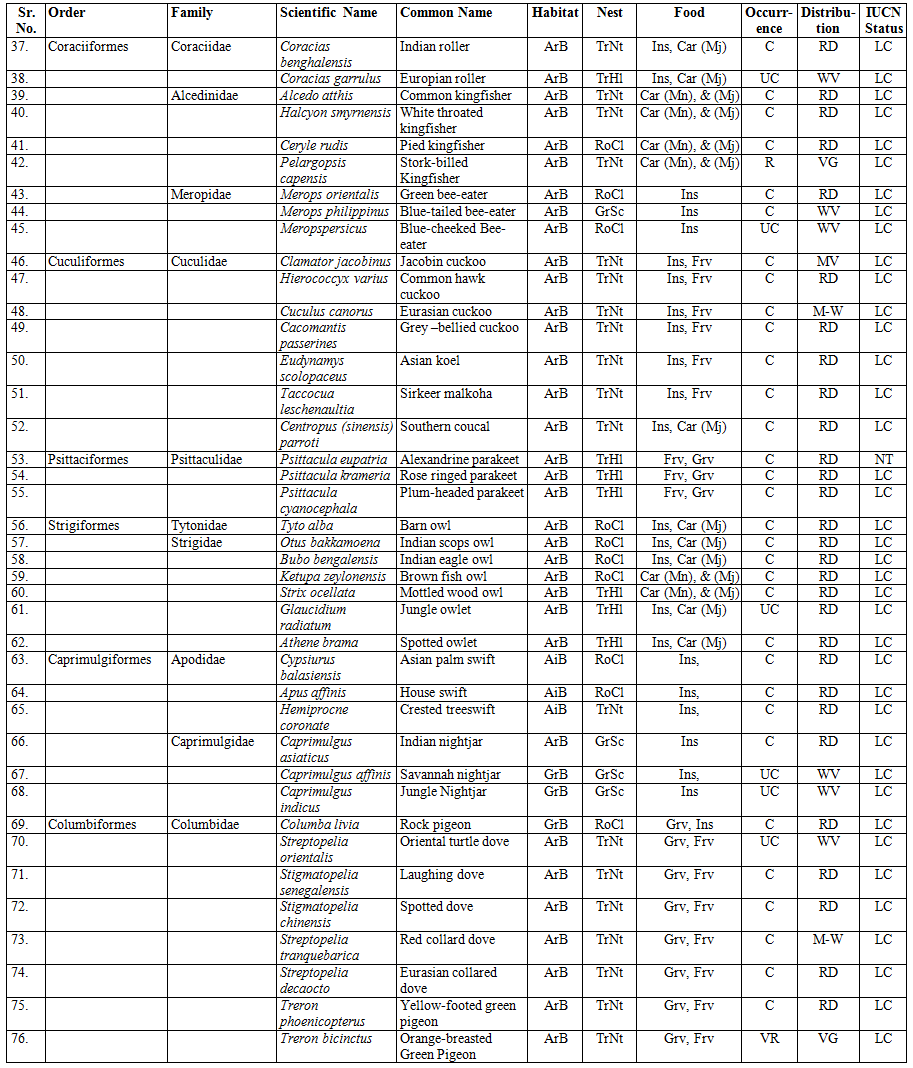
Table 1. (Part-C) Bird Diversity of Pandharkawada Forest Division
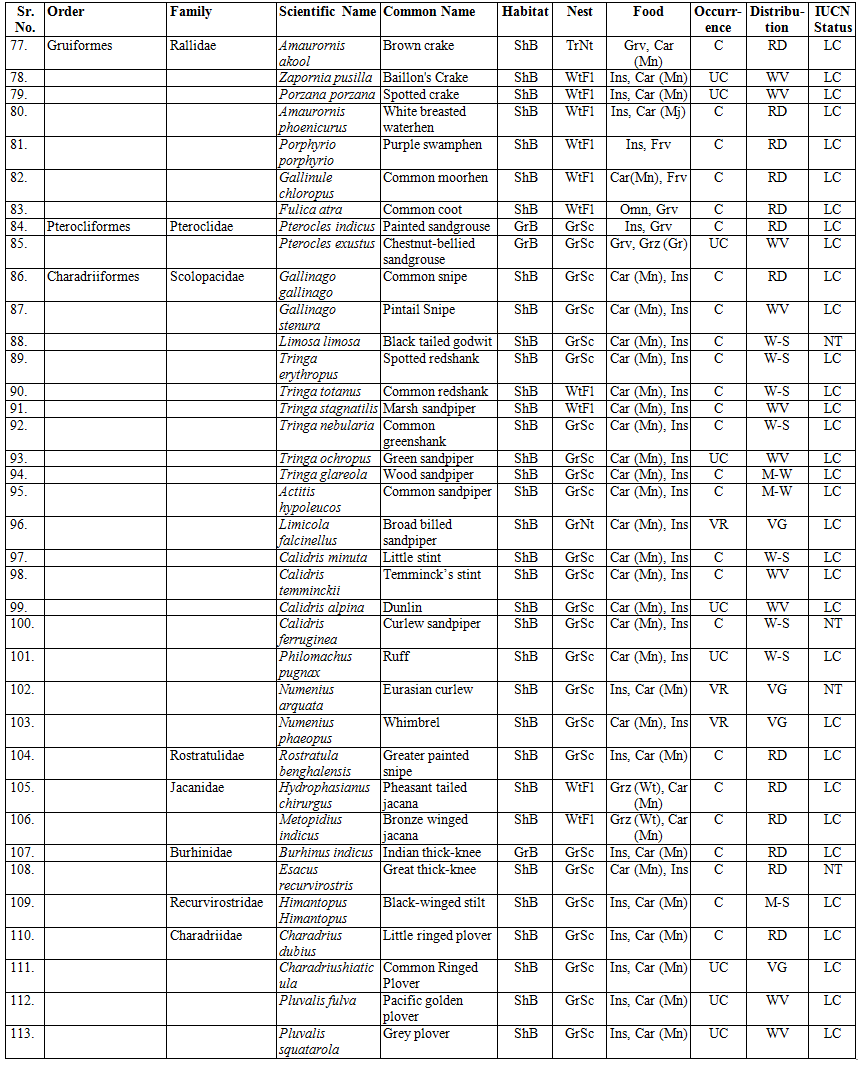
Table 1. (Part-D) Bird Diversity of Pandharkawada Forest Division
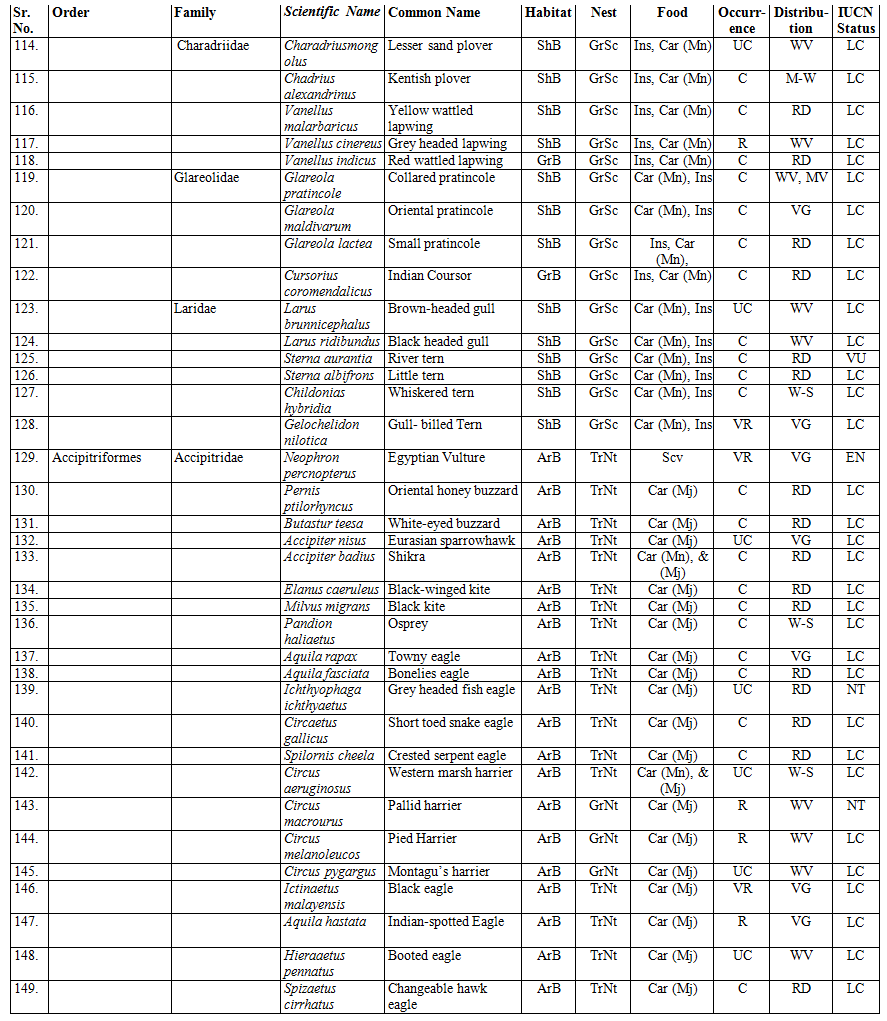
Table 1. (Part-E) Bird Diversity of Pandharkawada Forest Division
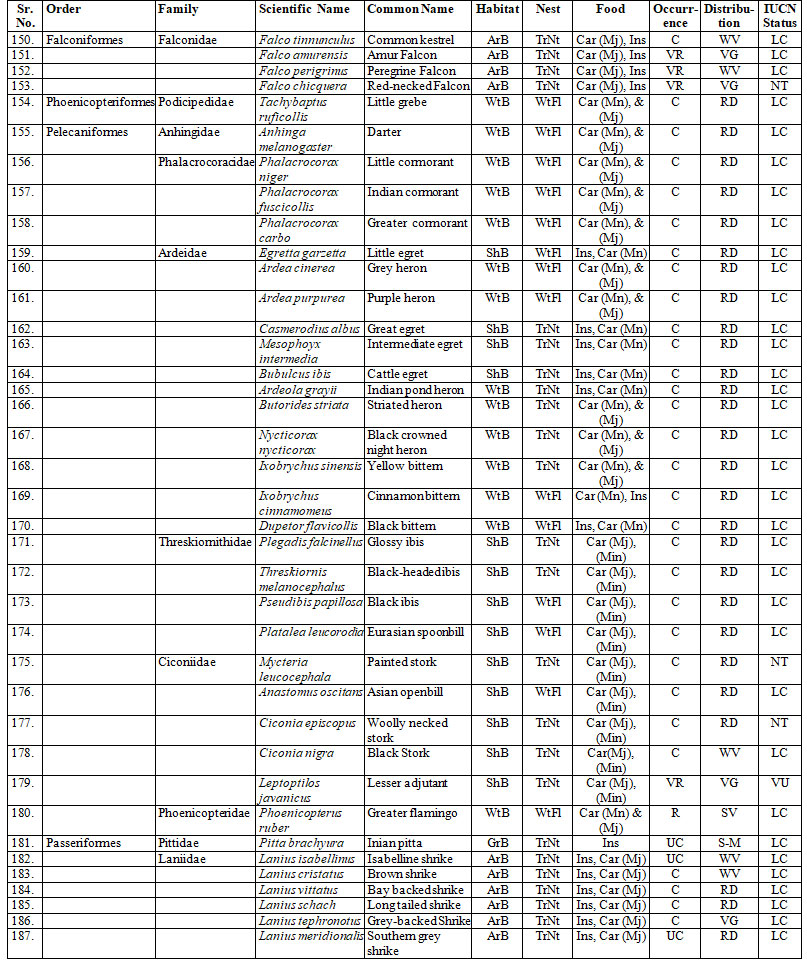
Table 1. (Part-F) Bird Diversity of Pandharkawada Forest Division
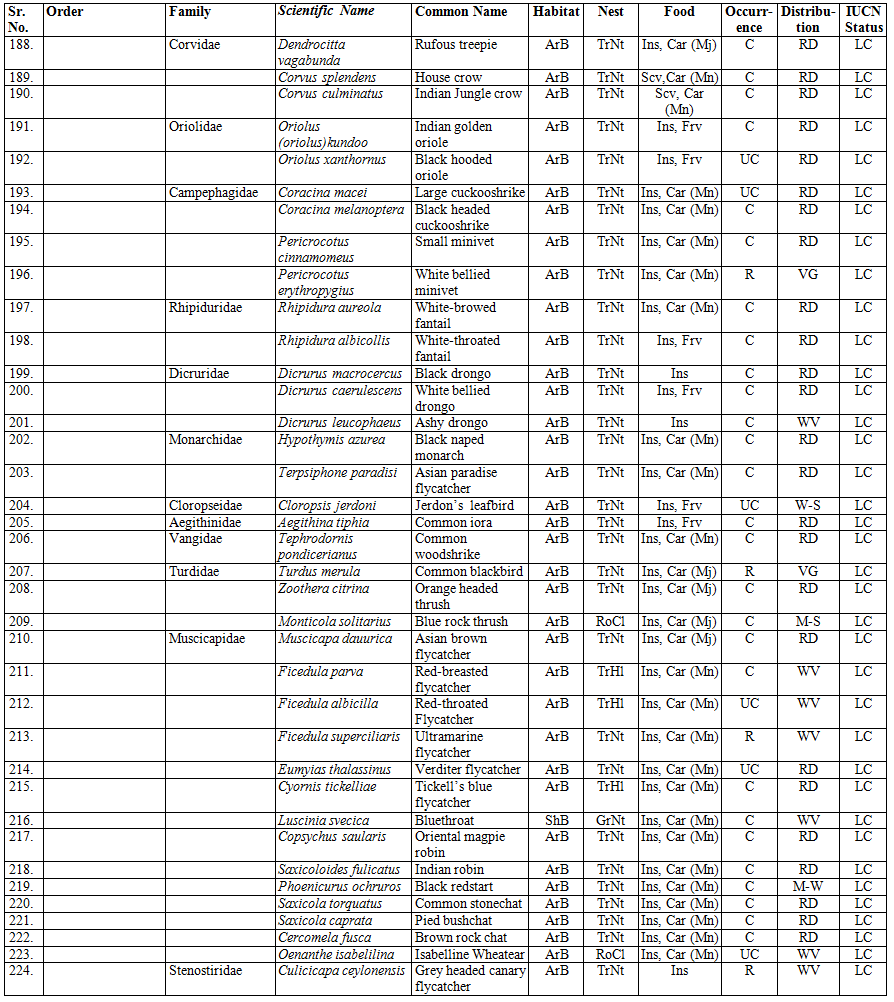
Table 1. (Part-G) Bird Diversity of Pandharkawada Forest Division
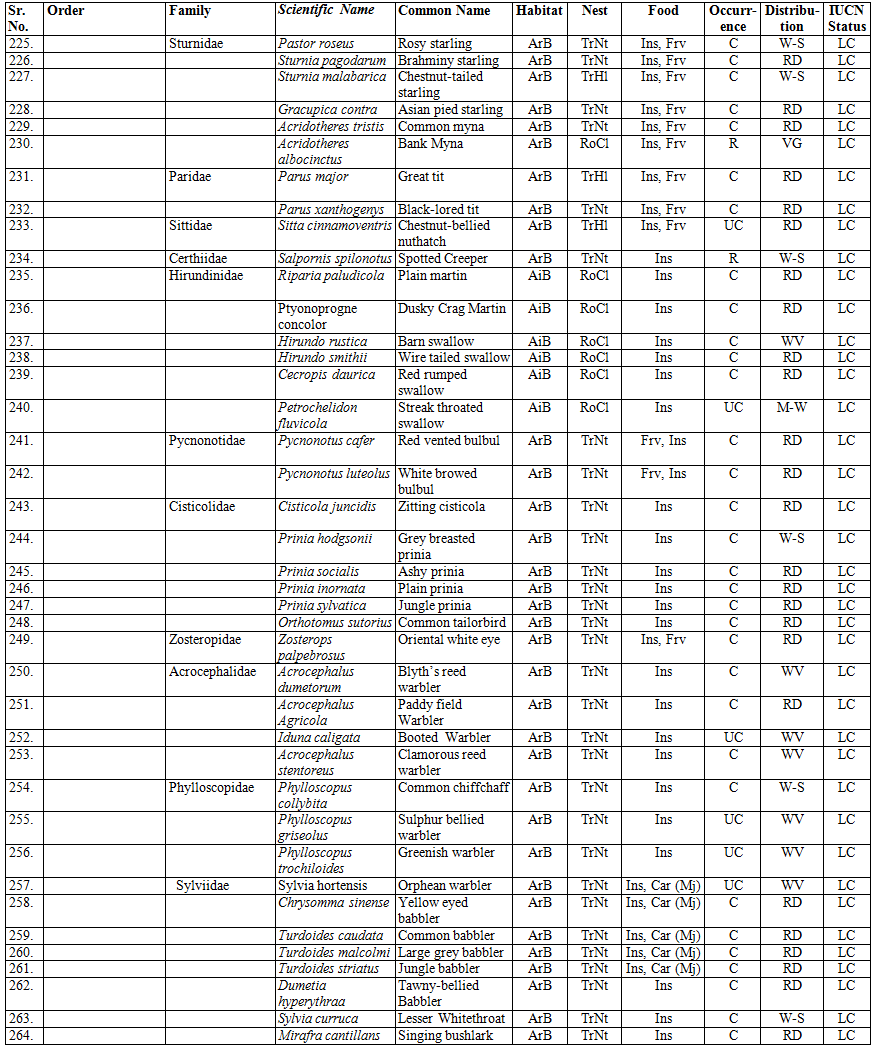
Table 1. (Part-H) Bird Diversity of Pandharkawada Forest Division
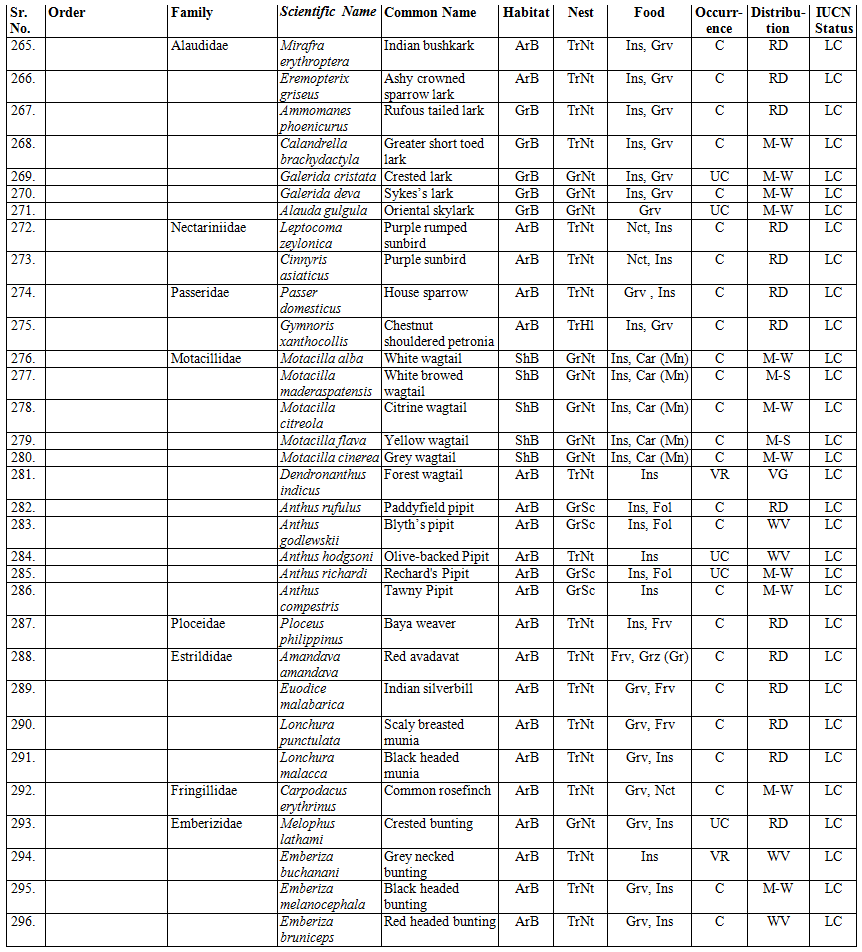
- Habitat: Water Birds – WtB; Shore Birds – ShB; Ground Birds – RrB; Arboreal bird – ArB; Aerial bird – AiB
- Nesting: Groud Scrap – GrSc; Ground Nest – GrNt; Tree Nest – TrNt; Tree Hole – TrHl; Rock Cleft – RoCl; Water Floating – WtF
- Food:Granivores – Grv; Frugivores – Frv; Nctariores – Nct; Foliores – Fol; Grazer (Terrestrial)- Grz (Gr); Grazer (Aquatic) – Grz (Wt); Insectiores- Ins; Omnivores – Omn; Carniores (Minor) – Car (Mn); Carniores (Major) – Car (Mj); Scavanger – Scv
- Occurrence: Common – C; Uncommon -UC; Rare – R; Very rare – VR
- Distribution: Resident –RD; Winter Visitor – WV; Monsoon Visitor – MV; Summer Visitor – SV; Vagrant – VG; Winter to summer W-S, Winter to monsoon W-M; Summer to monsoon – S–M; Summer to winter – S-W; Monsoon to winter – M- W, Monsoon to summer –M-S.
- IUCN Status: List concerned – LC; Near threatened – NT; Vulnerable – VU; Endangered – EN; Critically endangered – CR
Very Rare Species Recorded in Pandharkawada Forest Division

Rare Species of Birds Recorded from Pandharkawada Forest Division
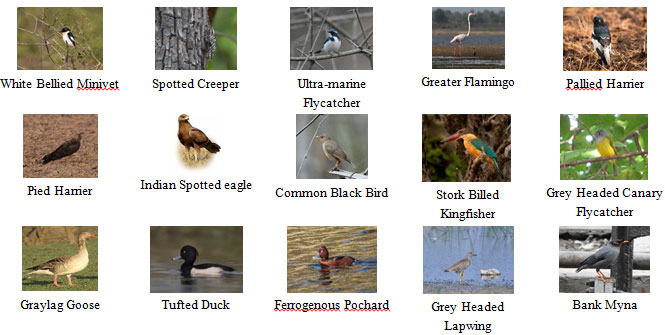
Near Threatened Species Recorded from Pandharkawada Forest Division

Vulnerable and Endangered Species Recorded from Pandharkawada Forest Division

All images source: Author’s collection
296 species of birds belonged to 19 orders and 67 family were recorded and photographed from Goplpur Nursery, Shibla Forest Range, Mandar Forest Range, Shindola scrubby forest, Saykheda dam, Wai dam, Mucchi dam, Karanwadi dam, Chilai dam, Bhimnala dam, Navargaon dam, Warud dam, Jam dam Nilgiri ban, Krishna Tekadi of Pandharkawada forest division dominated by order Passeriformes (Table 1 (ABCDEFGH parts), Fig.1).
219 (74%) were common, 49(17%) uncommon, 15(5%) rare and 13(4%) were very rare (fig.4). Locally rare recorded species were White Bellied Minivet, Spotted Creeper, Ultra-marine Flycatcher, Greater Flamingo, Pallied Harrier, Pied Harrier, Indian Spotted eagle, Common Black Bird, Stork Billed Kingfisher, Grey Headed Canary Flycatcher, Graylag Goose and Forest Wagtail, Eurasian Curlew, Whimbrel, Broad Billed Sandpiper, Lesser Adjutant, Orange headed Green Pigeon, Gull Billed Tern, Egyptian Vulture, Peregrine Falcon, Amur falcon, Red-necked Falcon, Grey-necked Bunting, Black eagle as very rare.
Main food habit of recorded species were insectivores and carnivorous followed by frugivores, granivores, terrestrial grazer, nectarivores, folivores, aquatic grazer, and scavengers (fig.2). Study of their habitat reveals 166 (56%) were arboreal, 66 (22%) as shore birds 31(10%) water birds 24 (8%) ground birds and 9 (3%) as arial birds (fig.3). Their nesting type is recorded as, 143 (48%) birds were recorded building their nests on tree, 51(17%) in ground scrap, 37 (12%) built nests floating on water 22 (8%) in ground, 22(8%) in tree hole and 21(7%) in rock cleft (fig,6).
Figure 1: Family wise species Diversity of Pandharkawada Forest Division
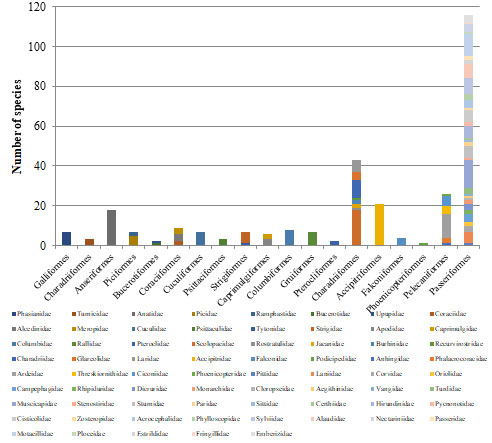
Figure 2: Food Habit

Figure 3: Habitat
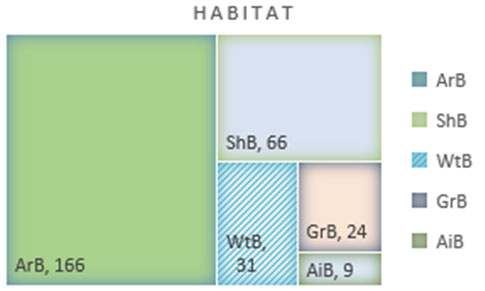
Figure 4: Occurrence
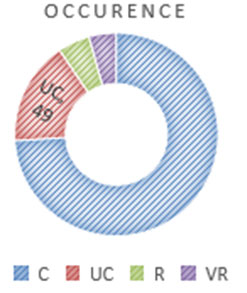
Figure 5: Distribution
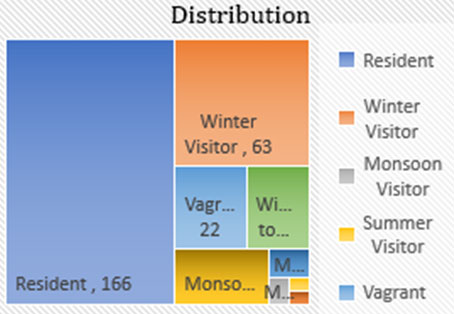
Figure 6: Nesting type

Figure 7: IUCN Status
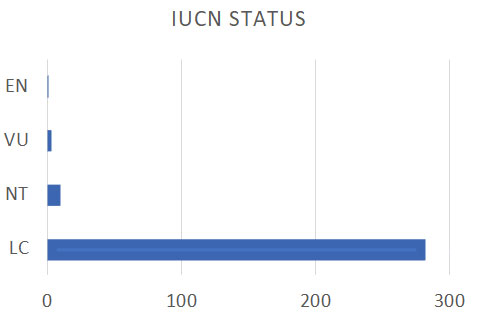
166 (56%) were resident and were found distributed in various habitat (21.28%), 63 were winter visitors and most amongst them were waterbirds, they spent winter at different waterbodies and seasonal wetlands in this division. 22 (7.50%) were Vagrant, 19 (6.41%) were distributed from winter to summer,19 (6.41%) was recorded from monsoon to winter, 4 were monsoon to summer, 2 were monsoon visitor, Greater flamingo was a summer visitor. (fig.5).
IUCN red data book conservation status of birds studied from Pandharkawada forest division shown that, Alexandrine Parakeet, Curlew Sandpiper, Great Thick-knee, Painted Stork, Grey Headed Fish Eagle, Black Tailed Godwit, Red-neck Falcon, Pallid Harrier these 10 species were near threatened. 2 species, Lesser adjutant, River tern were vulnerable and Egyptian Vulture is endangered. This study established that Pandharkawada forest division is rich in avifaunal diversity due to varied habitats like forest, grassy patches, shrubs, perineal waterbodies and seasonal wetlands. This attracts varieties of local resident and migratory species and different species were found distributed in different seasons of the year.
The results showed that in comparison to the avian diversity in the adjoining areas, the diversity in Pandharkawada area is significantly better. Major support systems for all kind of flora and fauna in general and birds in particular were forests and waterbodies. Waterbodies and seasonal wetlands were among the most productive ecosystems on the earth and attracts varieties of species of bird. These were under tremendous anthropogenic pressure due to commercial overexploitation and increasing lean period agriculture. Increasing anthropogenic pressure influenced the number of wintering waterbirds, their distribution, foraging behavior and interspecies competition (Chen, et al. 2011; Zhao et al. 2013; Zhou et al. 2010; Alice et al. 2020).
Changes in tropical wetlands led to the change in structure and function of the wetland ecosystems which affect the delivery of important ecosystem services, this loss of ecosystem services impacts human welfare (Alice et al. 2020). After enactment of forest right act 2006, there is tremendous increase in encroachments for individual and community forest rights. More recently, conversion of tropical forests to farmland is a main threat to extinction of bird species from a region, especially intact old-growth forest to agricultural and pastoral lands is among the greatest threats to biodiversity including birds (Gibbs et al. 2010; Tilman et al. 2001; Laurance et al. 2014; Hughes et al.2020; Rurangwa et al. 2021).
Increasing anthropogenic pressure, change in land use patterns, commercial exploitation of waterbodies and seasonal wetlands, forest fire, rampant grazing, overuse of pesticides and herbicides rapidly eating up natural habitats of birds in this forest division. To conserve the diversity in general and highly sensitive avifauna in particular, habitat conservation on landscape level is an essential instrument (Socolar and Wilcove 2019; Sayer et al. 2017; Hughes et al. 2020).
CONCLUSION
The findings of the present study will help in understanding local diversity, distribution, and conservation status of birds in this landscape which will help in drawing sustainable conservation strategies by balancing human demand and ecological services provided by these flying denizens.
ACKNOWLEDGEMENTS
This study was financially supported by Mrs. K.M. Abharna, Mr. G. Guruprasad, Mr. A.P. Girhepunje, Deputy Conservators of Pandharkawada Forest Division. Authors are thankful to them for giving permission and providing needed facilities for this research. Moreover, special acknowledgment is to Prof. Subodh Bansod, Vinayak Vidnyan Mahavidyalaya, Nandgaon (Kh), Dist. Amravati for his consistent help and support.
Conflict of interests: Authors declare no conflicts of interests to disclose.
REFERENCES
Ali, S. (2012) The Book of Indian Birds. Bombay Nat. Hist. Soc. Oxford University press (14).
Alice, N., Icely, J and Christina, S. (2020) Anthropogenic, Direct Pressures on Coastal Wetlands. Frontiers in Ecology and Evolution, 8(144): 1-29.
Asner, G. P., Rudel, T. K., Aide, T. M., et al. (2009) A contemporary assessment of change in humid tropical forests, Conservation Biology, 23(6): 1386–1395.
Chavhan, P.R. and Dhamani, A. A. (2014) Avian diversity in and around Chaprala wild life sancuary, dist. Gadchiroli, Maharashtra, India. International Journal of Fauna and Biological Studies, 1(6): 90-95.
Chen, J.Y., Zhou, L.Z. and Zhou, B. (2011) Seasonal dynamics of wintering waterbirds in two shallow lakes along Yangtze River in Anhui Province. Zoo. Res. 32: 540−548.
Dobrovolski, R., J. Diniz-Filho, A. F., Loyola, R. D et al. (2011) Agricultural expansion and the fate of global conservation priorities. Biodiversity and Conservation, 20(11): 2445–2459.
Gibbs, H. K., Ruesch, A. S and Achard, F. (2010) Tropical forests were the primary sources of new agricultural land in the 1980s and 1990s. Proceedings of the National Academy of Sciences of the United States of America, 107(38):16732–16737.
Grimmette, R., Inskipp, C. and Inskipp, T. (2000) Birds of the Indian Subcontinent. Oxford University press.
Harney, N.V. (2015) Avifaunal Diversity of Junona Lake near Chandrapur (M.S.) India. SAJMS, 3(1): 2348-7186.
Hughes, E. C., Edwards, D. P., Sayer, C. A., et al. (2020) The effects of tropical secondary forest regeneration on avian phylogenetic diversity. Journal of applied ecology, 57(7) :1351-1362.
Ingle, P., Sawdekar, M and Bal, S. (2015) Avifaunal Diversity of Tamkarada Forest, Near Malegaon Tehsil of Washim district, International Journal of Science and Research (IJSR), 4(6) : 643-646.
Kakade, V. R. (2012) A report on Avifaunal Diversity at and around Buldhana Town, District Buldhana (M.S.). Online International Interdisciplinary Research Journal, 2(1): 30-36.
Kasambe, R. and Sani, T. (2009) Avifauna in and around Nagpur city of Maharashtra: an Annotated contemporary checklist. Newsletter for Birdwatchers 49(3): 35-40.
Kedar, G.T. (2012). Ambazari Lake – A potential stopover point of winter migrant in Central India. Indian Streams Research Journal, 2(6) :1-8.
Laurance, W. F., Sayer, J and Cassman, K. J. (2014) Agricultural expansion and its impacts on tropical nature. Trends in Ecology & Evolution, 29(2): 107–116.
Lundberg, J and Moberg, F. (2003). Mobile link organisms and ecosystem functioning: Implications for ecosystem resilience and management. Ecosystems, 6(1): 87–98.
Mulwa, R. K., Böhning-Gaese, K and Schleuning, M. (2012) High bird species diversity in structurally heterogeneous farmland in Western Kenya. Biotropica, 44(6): 801–809.
Ndang’ang’a, P. K., Githiru, K and Njoroge, J. M. (2013). Vegetation composition and structure influences bird species community assemblage in the highland agricultural landscape of Nyandarua. Kenya. Journal of African Ornithology, 84: 171–179.
Paliwal, G.T. (2013). Observation an Aquatic and Terrestrial Biodiversity at Navegaon National Park. District Gondia, Maharashtra. PhD thesis, R.T.M. Nagpur University.
Rurangwa, M. L., Aguirre-gutiérrez, J., Matthews, T. J., et al. (2021) Effects of land‐use change on avian taxonomic, functional and phylogenetic diversity in a tropical montane rainforest. Diversity and Distributions. Https://doi.org/10.1111/ddi.13364
Sayer, C. A., Bullock, J. M and Martin, P. (2017) Dynamics of avian species and functional diversity in secondary tropical forests. Biological Conservation, 211: 1-9.
Şekercioğlu, C. H., Daily, G. C and Ehrlich, P. R. (2004) Ecosystem consequences of bird declines. Proc Natl Acad Sci U S A, 101(52): 18042–18047.
Sekercioglu, C. H. (2006) Increasing awareness of avian ecological function. Trends in Ecology and Evolution 21(8): 464-471.
Socolar, J. B and Wilcove, D. S. (2019) Forest-type specialization strongly predicts avian responses to tropical agriculture. Proc. R. Soc. B, 286: 1-9.
Tilman, D., Fargione, J and Wolff, B. (2001) Forecasting agriculturally driven global environmental change. Science, 292(5515): 281–284.
Wadatkar, J. S. and Kasambe, R. (2002) Checklist of birds from Pohara-Malkhed reserve Forest, district Amravati, Maharashtra. Zoo’s Print J., 17:807-811.
Wagh, G and Tiwari, P. (2020) On the Diversity and Abundance of Avian Species from Grassland and Wetland Areas of an Industrial Area of Tropical Maharashtra. Bioscience Biotechnology Research Communication, 13(2): 770-780.
Whelan, C. J., Wenny, D. G and Marquis, R. J. (2008) Ecosystem services provided by birds. Annals of the New York Academy of Sciences, 1134: 25–60.
Zhao, F.T., Zhou, L.Z., and Xu, W. B. (2013) Habitat utilization and resource partitioning of wintering hooded cranes and three goose species at Shengjin Lake. Chin Birds, 4: 281–290.
Zhou, B., Zhou, L. Z., and Chen, J. Y. (2010) Diurnal time-activity budgets of wintering hooded cranes (Grus monacha) in Shengjin Lake, China. Waterbirds, 33:110–115.


